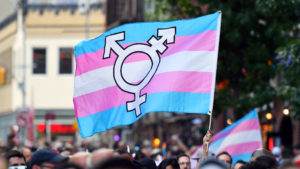I assumed Harvey Marcelin was an elderly woman guilty of some sort of financial crime when I first read the charge sheet. The Department of Corrections website describes a six-foot, black female, born in 1938, charged with defrauding the government.
But Harvey is not a woman. He is a male serial killer.
The New York Times, formerly a paper of record, but more recently a censorious mouthpiece, referred to Marcelin its report as, “An 83-year-old Brooklyn woman”. In fact, almost all media reports of his latest crime – murdering and dismembering a woman he met two years ago online – refer to Marcelin as “she” and “her”.
Marcelin already has two convictions for killing women, and has served much of the past five decades in jail. He was released in 2019, but earlier this month, he was taken into custody again, after the severed remains of Susan Leydon were discovered at his home and local area. The “defrauding the government” on the charge sheet referred to his attempts to cover up his crime.
Marcelin began his long career of violence with an assault charge in 1957. In 1963, he was arrested and charged with attempted rape, but the case was dropped when the victim didn’t show up to court. As violent men do, he escalated, and murderered Jaqueline Bonds on 18 April 1963. He shot her in the head in front of witnesses in Harlem. He was convicted of murder and sentenced to 20 years to life.
While in prison, Marcelin served repeated stints in solitary confinement, about which he submitted numerous complaints that this amounted to “cruel and unusual punishment”. All were dismissed. Then, in 1984, having served only 13 years of his sentence, he was released on lifetime parole.
The following year, 1985, he fatally stabbed Anna Laura Serrera Miranda and dumped her body in a bag on a roadway near Central Park. Despite this being the second woman he had killed, he plea bargained down from murder to first degree manslaughter and was sentenced to just six to 12 years.
Every two years, Marcelin unsuccessfully applied for parole. At one hearing, he blamed his crimes on “youth and poor judgement and stupidity”, and was rebuked by a parole officer, who told him he was a “grown ass man”. Marcelin complained about this comment, but it went nowhere.
Following his 1997 parole hearing, Marcelin submitted a complaint to the court that he had been denied a fair hearing because all three members of the parole board were women. He felt that the nature of his crimes would lead women to be biased against him, telling the court, “I have problems with women.” But his complaint was rejected by a three-judge panel as speculative and baseless.
In 2001, according to the court filing, a guard “observed the prisoner [Marcelin] engaged in an act of oral intercourse with another inmate”. He had to face a hearing about it, but no penalty was applied. Eventually, in 2019, the parole board made the decision to release him.
On 27 February this year, Susan Leyden was seen entering Marcelin’s apartment, carrying a multi coloured bag. On 3 March, a woman’s torso was discovered in a garbage bag in a shopping cart on a busy street in East New York, Brooklyn during the early morning hours. Five days later, a leg was discovered in Cypress Hill only blocks away from where the torso was discovered. The next day, detectives questioned Marcelin following reports that he had been seen leaving the apartment with the same bag. A search of Marcelin’s home turned up a human head, and electric saws he had bought from a nearby Home Depot. Then a severed leg was found, four blocks away, poking out of a tire, cut from the knee down and still wearing a sock. Astonishingly, Marcelin was caught on CCTV in a 99-cent store in Brooklyn, in his wheelchair, with Leydon’s severed leg, wrapped in a garbage bag.
Nora1, an experienced lawyer and feminist campaigner based in Brooklyn, is furious. “It outrages me that this perpetrator murdered one woman, was released on parole, then brutally murdered a second woman within months and was later paroled again. How would that be possible in a world that valued women’s lives?” She tells me that even with serial murders of women, some victims are seen as expendable.
At the time of his arrest, Marcelin was living at Stonewall House, New York City’s first LGBT-welcoming senior housing. No one seems to know when Marcelin began identifying as a woman, but there is no evidence that he had undergone treatment of any kind, and it would appear that he was presenting as male until very close to the discovery of Leydon’s remains.
“He needs to be incarcerated,” Nora says. “But at the same time, we need to protect incarcerated women. How would I feel if a woman I cared about were put in a cell with this defendant? I’m worried about women being confined with this person. We have to be able to talk about those concerns.”
I also spoke to Oren Yaniv, Director of Communication at Brooklyn District Attorney’s Office about Marcelin’s case. At first, Yaniv used male pronouns to refer to Marcelin, then within a couple of minutes he suddenly switched to “she”.
“I don’t know what her driver’s license says,” he told me, when I asked if Marcelin had legally transitioned. “Usually in the US these days it is based on a person’s preference, so right now she identifies as a woman, and we are respecting that.” So does that mean Marcelin will be held in female correctional facilities? “To the best of my knowledge, yes,” he replied.
But what about the risk he may pose to the women incarcerated with a male serial killer? Wasn’t this of concern to the DA?“I’m sure that they are taking precautions now,” Yaniv said, “this individual has spent… years in prison already, where to my knowledge they did not kill anybody, I don’t think there are too many chainsaws in prison but… she won’t be the only accused murderer that’s being held in Riker and they have policies and precautions to, you know, minimise the violence of it.”
He also confirmed at trial, “we respect the person’s gender identity… She identifies as a woman, and we refer [to] her as a woman.” Marcelin will be referred to in court as she/her. The DA’s office and the correctional facilities will “respect” Marceline’s gender identity, make the bold assumption that his transition is genuine, call him she/her in court, and put him in prison with women.
Susan Leyden, Marcelin’s latest victim, was a devoted single mother. At her funeral, her daughter Nicole said, “Mom had a heart of gold. She was so much fun to be around. Our relationship was more like sisters at times. Perhaps because it was just the two of us, I never wanted to leave her side.”
I feel for Leyden’s daughter, and her family, and the families of the other victims. They will have to listen to the court referring to a male serial killer as “she” and “her”. They will have to live with the fact that the second and third murders were entirely foreseeable and preventable if the authorities had only acted. And all the women who will be incarcerated with this man, and who are already vulnerable will know that they have been put seriously at risk.
Marcelin epitomises the worst example of unbridled male violence, and to pretend he is the same sex as those whose lives he destroyed is nothing short of an abomination.
It’s hard to deny that the practice of self-identification is increasingly open to abuse — in the UK, as well as in America. Only last week Baroness Nicholson broke the story of the rape of a woman in a female ward by a male-bodied transwoman, who had been allowed in the ward thanks to the acceptance by the NHS of self-identification.
Gender identity ideology often comes packaged in warm and fuzzy clichés. “Trans women are women”; “What impact does it have on your life anyway?”; “Can’t you just be kind?” But for how much longer can we ignore the grave consequences for women when predatory men take advantage of the new rules of this ideology.
FOOTNOTES
- Not her real name
Disclaimer
Some of the posts we share are controversial and we do not necessarily agree with them in the whole extend. Sometimes we agree with the content or part of it but we do not agree with the narration or language. Nevertheless we find them somehow interesting, valuable and/or informative or we share them, because we strongly believe in freedom of speech, free press and journalism. We strongly encourage you to have a critical approach to all the content, do your own research and analysis to build your own opinion.
We would be glad to have your feedback.
Source: UnHerd Read the original article here: https://unherd.com




